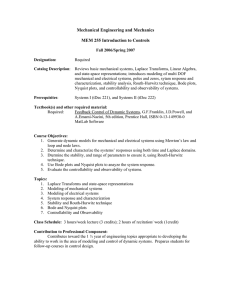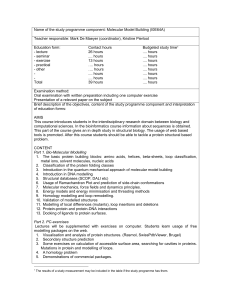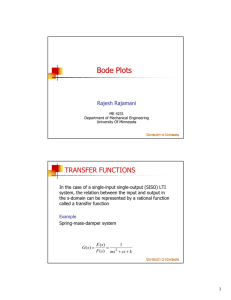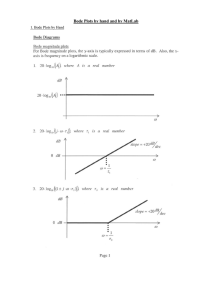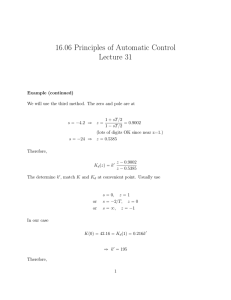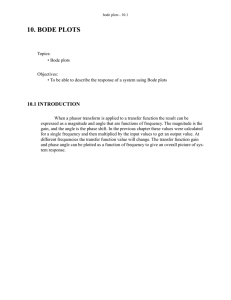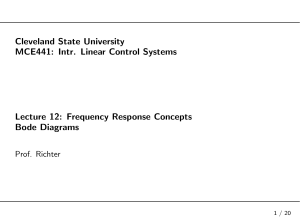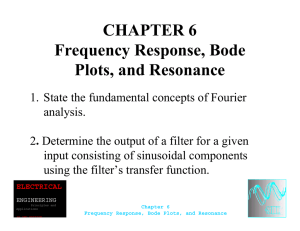MODULE DESCRIPTOR MECH3005 - Automatic Control
advertisement
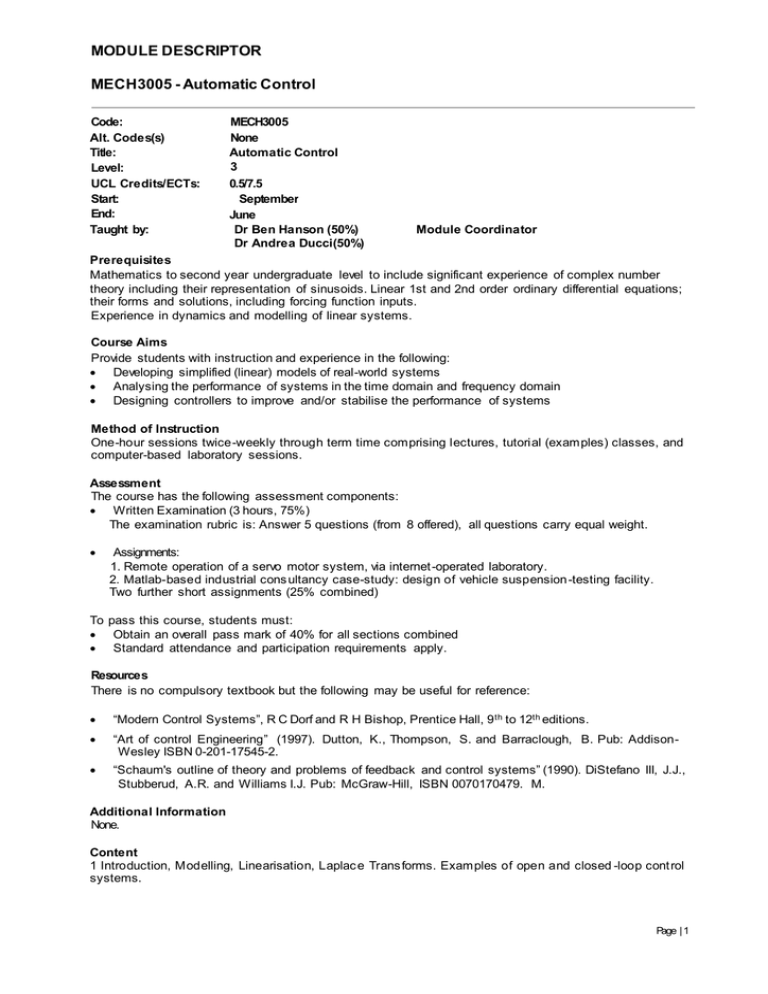
MODULE DESCRIPTOR MECH3005 - Automatic Control Code: Alt. Codes(s) Title: Level: UCL Credits/ECTs: Start: End: Taught by: MECH3005 None Automatic Control 3 0.5/7.5 September June Dr Ben Hanson (50%) Dr Andrea Ducci(50%) Module Coordinator Prerequisites Mathematics to second year undergraduate level to include significant experience of complex number theory including their representation of sinusoids. Linear 1st and 2nd order ordinary differential equations; their forms and solutions, including forcing function inputs. Experience in dynamics and modelling of linear systems. Course Aims Provide students with instruction and experience in the following: Developing simplified (linear) models of real-world systems Analysing the performance of systems in the time domain and frequency domain Designing controllers to improve and/or stabilise the performance of systems Method of Instruction One-hour sessions twice-weekly through term time comprising lectures, tutorial (examples) classes, and computer-based laboratory sessions. Assessment The course has the following assessment components: Written Examination (3 hours, 75%) The examination rubric is: Answer 5 questions (from 8 offered), all questions carry equal weight. Assignments: 1. Remote operation of a servo motor system, via internet-operated laboratory. 2. Matlab-based industrial cons ultancy case-study: design of vehicle suspension -testing facility. Two further short assignments (25% combined) To pass this course, students must: Obtain an overall pass mark of 40% for all sections combined Standard attendance and participation requirements apply. Resources There is no compulsory textbook but the following may be useful for reference: “Modern Control Systems”, R C Dorf and R H Bishop, Prentice Hall, 9 th to 12th editions. “Art of control Engineering” (1997). Dutton, K., Thompson, S. and Barraclough, B. Pub: AddisonWesley ISBN 0-201-17545-2. “Schaum's outline of theory and problems of feedback and control systems” (1990). DiStefano III, J.J., Stubberud, A.R. and Williams I.J. Pub: McGraw-Hill, ISBN 0070170479. M. Additional Information None. Content 1 Introduction, Modelling, Linearisation, Laplac e Trans forms. Examples of open and closed -loop cont rol systems. Page | 1 2 Control specifications: Step response and Steady State Error. Pole Mapping, Routh-Hurwitz stability criterion. 3 Root Locus methods: Angle & Magnit ude criteria, Roots on the real axis, Breakaway points, Asymptotes, Pole placement controller design, stabilisation controllers. 4 Frequency Response Methods: Polar plots of 1st, 2nd order systems, Bode plots, Combini ng B ode plots, System identification from the Bode plot. 5 Stability in the Frequency Domain: Nyquist stability criterion, Phase and Gain margins on polar and Bode plots, M circles of closed loop magnitude. 6 Controller Design: Defining system performance requirements, Lead, Lag and PID cont roller design from the frequency response and root locus. 7 Further Control Conc epts: Modelling nonlinearities using a describing function, pure delays, digital control, state space methods. Page | 2 General Learning Outcomes Knowledge and Understanding Essential elements of control systems; theoretical analysis of linear time-invariant and frequency-invariant control systems; modelling of mechanical and electromechanical system s; mathematical and analytical tools for control systems design; an insight of the application of digital control in engineering systems. Skills and Attributes (i) Intellectual Select and apply mathematical methods for modelling and analysing the response of linear time-invariant and frequency-invariant control systems; solve engineering problems involving industrial control applications. (ii) Practical Undertake a system identification experiment, collect and analyse the data in detail and effectively communicate this procedure and the outcomes in a formal report; the use of MatLab in the simulation and analysis of a control system. (iii) Transferable Model and analyse engineering systems; use technical data in the solution of engineering problems; utilise control principles for real-world applications. Page | 3
